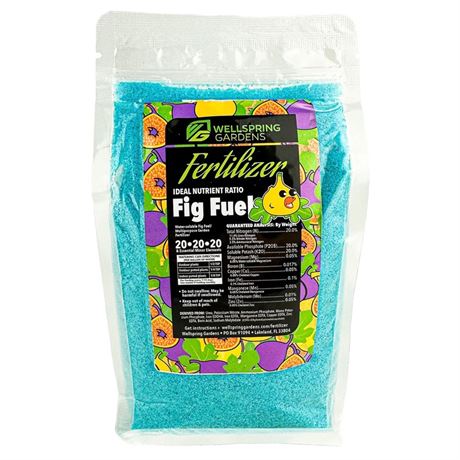Fig Fuel Fertilizer - Water-Soluble 20-20-20 - 2 LB bag 
* * FREE SHIPPING * * FREE SHIPPING * * FREE SHIPPING * *
Other $0.00
Free Shipping
Seller Accepts PayPal
Seller Accepts Credit Cards
Please click the 'Buy it Now' or 'Bid' button once. Multiple clicks may result in multiple purchases. Pay directly from the listing or invoice. We ship on Tue, Wed, and Thu. Thank you for purchasing! :)
Fig Fuel
We've always fertilized our potted fig tree collection regularly. Before installing a Dosatron to the drip system it was a daunting task. The big box store water-soluble fertilizer made it much easier and it worked well enough. We added some Alaska fish fertilizer and Superthrive and fertilized once every 7-10 days from spring to August 30th. When the Dosatron was installed we switched to a weak solution of fertilizer and ran it every day. What a difference! The weak solution really supercharged the girls! We are already a Banana Fuel customer and recently worked Wellspring's Fig Fuel fertilizer into our schedule with much better results than Miracle-Gro. Fig Fuel goes a looong way, too, which is a bonus when you're trying to save a little money. I think we'll be Fig Fuel customers for a long time.
This is a 2 lb bag of Fig Fuel water-soluble fig tree fertilizer. Each purchase of Fig Fuel ships for FREE!
- Click here for the 1 lb bag of Fig Fuel.
- Click here to see Wellspring's full line of fuel fertilizer products on figBid.
From Wellspring:
We've consulted with the experts (and we've tested it for years) and we have found that 1-1-1 is the best fertilizer ratio for fruiting fig trees. Our brand of fig fertilizer packs much more potency in its small bag than other brands, because at 20-20-20, it's got twice as many nutrients as a 10-10-10 bag. We are very proud to now offer Fig Fuel, a premium water-soluble plant food, especially suitable for fig trees that produce fruit. Fig Fuel will also work on a fiddle leaf fig tree that you keep as a houseplant, but it is specifically designed for fruiting figs.
Every 1-2 weeks, use a one-gallon watering can with warm water and agitate the amount of fuel specified below to water your fig trees:
• Indoor potted fig trees: 1/8 teaspoon
• Outdoor potted fig trees: 1/4 teaspoon
• In-ground fig trees: 1/2 teaspoon
What are water–soluble fertilizers?
Water–soluble fertilizers are powdered. Small amounts are measured and poured into room temperature water or slightly warm water. These fertilizers can be mixed right into a watering can or a bottle and used immediately or stored for a few days before use.
What do fertilizer numbers mean?
Different plants have different nutrient requirements, but all plants need 18 elements for optimum growth and health. These elements consist of macronutrients, intermediate nutrients, and micronutrients. Fertilizer numbers represent 3 of the major macronutrients that plants require. These numbers are typically displayed in a format like N-P-K, where each number corresponds to a specific amount of nutrient contained in the fertilizer.
Macronutrients
N-P-K or nitrogen (N), phosphorus (P), and potassium (K) are known as the primary macronutrients. The numbers on any container of fertilizer will always be listed in that order and tell you the proportion of each nutrient in the product. For example, a bag of fertilizer labeled as "10-20-10" contains 10% nitrogen (N), 20% phosphorus (P), and 10% potassium (K) by weight. This formula is 40% fertilizer by weight.
- Nitrogen (N) - Nitrogen is crucial for promoting leafy, green growth in plants, stems, and overall plant vigor.
- Phosphorus (P) - Phosphorus is important for good root development, flower, and fruit production.
- Potassium (K) - Potassium supports various aspects of plant health, such as disease resistance, drought tolerance, and overall stress resistance. Potassium also plays a role in fruit and seed development.
You should always choose a fertilizer with an N-P-K ratio that suits the specific needs of your plants.
Intermediate Nutrients
Intermediate nutrients, also known as secondary nutrients, play important roles in plant growth and development and are often found in sufficient quantities in most soils and water. Plants require intermediate nutrients in smaller quantities than primary macronutrients. In some cases, supplemental fertilization may be necessary to address intermediate nutrient deficiencies. Each intermediate nutrient can be found separately or added to fertilizer products. Intermediate nutrients added to fertilizer products are not represented by the three numbers or N-P-K. Intermediate nutrients added to any fertilizer will be listed on the label in the specific proportion they're added. The intermediate nutrients are:
- Calcium (Ca) - Calcium is essential for cell wall structure and stability. Calcium also plays a role in nutrient uptake, enzyme activation, and neutralizing soil acidity. Calcium deficiency can lead to issues like blossom end rot in tomatoes.
- Magnesium (Mg) - Magnesium is vital for photosynthesis. Magnesium is also involved in the activation of enzymes and energy transfer within the plant. Magnesium deficiency can lead to yellowing between the veins of older leaves.
- Sulfur (S) - Sulfur is a component of amino acids, proteins, and some vitamins. Sulfur plays a role in the formation of chlorophyll and is directly involved in several metabolic processes. Sulfur deficiency can result in yellowing of new leaves.
Micronutrients
Plant micronutrients, also known as trace elements, are essential nutrients required by plants in smaller quantities than intermediate nutrients. Typically, micronutrients are measured in parts per million (ppm) or milligrams per kilogram of soil. Despite their small quantity, these micronutrients play critical roles in various biochemical and physiological processes in plants. The absence or deficiency of micronutrients can lead to various growth abnormalities, reduced yields, and increased susceptibility to diseases and environmental stress. The most important plant micronutrients are:
- Iron (Fe) - Iron is crucial for the synthesis of chlorophyll, which is essential for photosynthesis. Iron deficiency in plants leads to chlorosis, resulting in yellow leaves with green veins.
- Manganese (Mn) - Manganese is necessary for photosynthesis, respiration, and nitrogen metabolism. Deficiencies can cause interveinal chlorosis and poor seed formation.
- Zinc (Zn) - Zinc is involved in enzyme activation, particularly in the formation of growth-regulating hormones and the synthesis of proteins. Zinc deficiency can result in stunted growth, leaf deformities, and poor fruit or seed development.
- Copper (Cu) - Copper plays a role in photosynthesis, respiration, and the formation of lignin. Copper deficiency may lead to wilting, poor growth, and reduced seed or fruit set.
- Boron (B) - Boron is important for cell wall formation, carbohydrate metabolism, and pollen tube growth. Boron deficiency can result in brittle or cracked stems and distorted growth.
- Molybdenum (Mo) - Molybdenum is required for nitrogen fixation in legumes and the activation of specific enzymes. Molybdenum deficiency can lead to nitrogen-related issues and reduced growth.
- Chlorine (Cl) - Chlorine, primarily taken up as chloride ions, is involved in photosynthesis and osmoregulation in plants. Chlorine deficiency is relatively rare and can cause reduced growth and wilting.
It's important for gardeners to be aware of the specific micronutrient needs of the plants they are growing and, if necessary, provide micronutrient supplements through fertilizers or soil amendments.
Values
Formulas with small numbers, such as 6-6-6, are referred to as “low-analysis” fertilizers. Low analysis fertilizers are often used when a plant's nutrient requirements are not very high, or when you want to provide balanced nutrition without the risk of over-fertilization. Low-analysis fertilizers are also helpful when you want to apply a fertilizer with a specific nutrient ratio for a particular stage of plant growth or when addressing a specific nutrient deficiency. Low-analysis fertilizers are suitable for a wide range of applications, including general garden use, lawns, and landscaping.
Fertilizers with larger numbers, such as 20-20-20, are “high-analysis.” In general, any fertilizer with N-P-K numbers significantly higher than balanced ratios (e.g., 10-10-10) can be considered a high-analysis fertilizer. High-analysis fertilizers are often used when plants have increased nutrient demands, such as during periods of rapid growth, fruiting, or flowering. They are especially useful for crops that require a substantial supply of nutrients, like vegetables, fruits, and certain ornamental plants.
What is the difference? A 3-pound bag of 20-20-20 is equal to a 10-pound bag of 6-6-6 if other things are equal. Ex: 3 pounds of 20-20-20 [3x(20+20+20)=180] is equal to 10 pounds of 6-6-6 [10x(6+6+6)=180]. Factors that increase quality and price include micronutrient inclusion, high analysis, and slow release.
Wellspring Gardens has an agreement with NYCfigs to distribute Banana Fuel Fertilizer on FigBid.com. Your order will ship directly from Wellspring Gardens' nursery in Central Florida.
- Item # 48170230
- 666 Page Views

